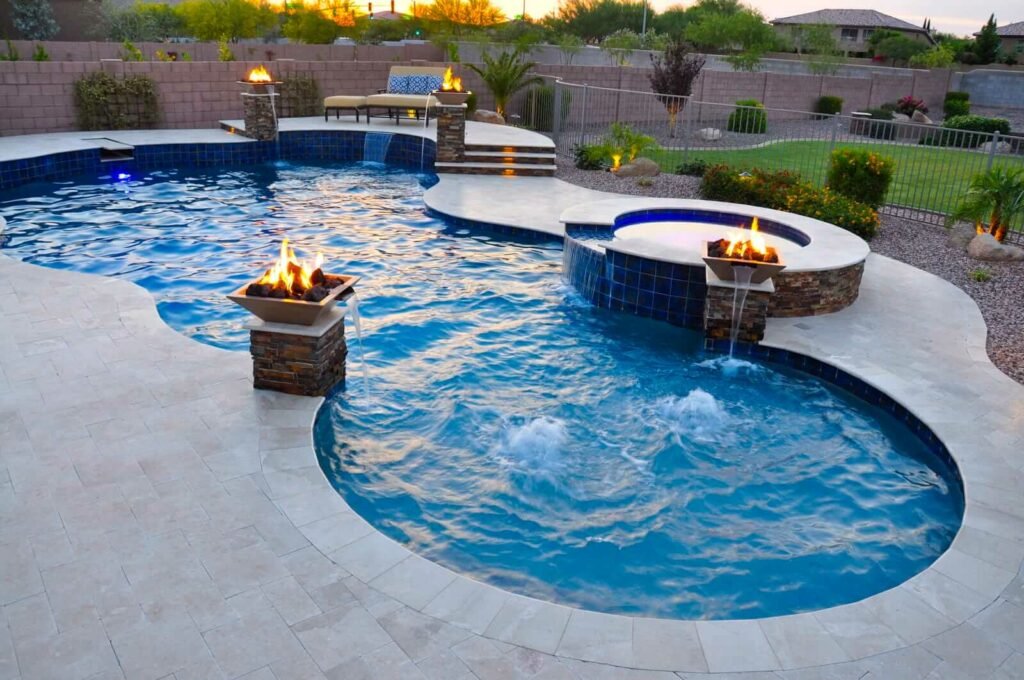Rethinking Luxury in a Drying Climate
Texas summers are no joke. Scorching temperatures, rising drought conditions, and unpredictable rainfall are forcing homeowners to reconsider how they use—and conserve—water. Yet, even in this changing climate, the backyard pool remains a Texas staple.
This raises a compelling question: how can homeowners enjoy their pools without wasting precious water? The answer lies in sustainable pool design. From smarter filtration systems to drought-conscious landscaping, Texas homeowners are discovering that modern pool renovations can create refreshing retreats that are both beautiful and environmentally responsible.
The Texas Drought Dilemma
The Lone Star State has experienced recurring droughts for decades, but recent years have brought more frequent and intense dry spells. Central and South Texas, including San Antonio, face particular challenges due to long hot seasons and limited rainfall.
Traditional pools consume significant water, both for filling and maintenance. Evaporation alone can drain thousands of gallons annually in a region where every drop counts. This has made water conservation a growing priority for Texas homeowners—and innovation in pool design has risen to meet it.
Smarter Filtration and Circulation Systems
One of the biggest water wasters in older pools is inefficient filtration. Traditional single-speed pumps run continuously, consuming excess energy and leading to higher evaporation.
Modern variable-speed pumps and advanced filtration systems allow for precise control, using only the power needed for circulation. They minimize water loss while cutting energy bills, an especially welcome benefit given Texas’ high utility costs.
Additionally, modern filters trap finer particles, reducing the need for frequent backwashing—a process that wastes hundreds of gallons of water.
Pool Covers: The Simplest Conservation Tool
Sometimes, the simplest solutions make the biggest impact. Evaporation is the single largest source of water loss from Texas pools. Installing a pool cover—manual or automatic—can reduce evaporation by up to 90%.
Covers also keep debris out, meaning less time spent cleaning and fewer chemical treatments. In South Texas, where wind and dust are common, this small upgrade can dramatically extend a pool’s lifespan and lower maintenance needs.
The Rise of Saltwater and Natural Pools
Another trend among Texas homeowners is switching from chlorine pools to saltwater or natural systems. Saltwater pools use a salt-chlorine generator to sanitize water, which means fewer chemical refills and a softer, more skin-friendly swimming experience.
Meanwhile, natural pools use biological filters—plants and gravel beds—to purify water, mimicking the self-cleaning systems found in nature. These eco-friendly alternatives align perfectly with Texas’ growing interest in sustainability and outdoor living harmony.
Designing for Efficiency: The Role of Landscaping
Water-wise landscaping is the unsung hero of sustainable pool design. Strategic placement of shade trees, pergolas, or even shade sails reduces evaporation and keeps pool areas cooler during sweltering Texas afternoons.
Homeowners in Central Texas often opt for xeriscaping—a landscaping method that uses drought-tolerant plants, decorative rock, and native grasses. Not only does this minimize water use, but it also enhances the aesthetic appeal of the backyard.
The combination of a sleek, renovated pool with modern desert-inspired landscaping creates a visually striking and eco-conscious outdoor retreat.
Cooling Off Without Heating Up Energy Bills
Many Texans dream of extending their swimming season beyond summer, but heating systems can be energy-intensive. Solar heating panels and high-efficiency heat pumps provide greener alternatives. They harness renewable energy or ambient air to maintain comfortable water temperatures without skyrocketing utility costs.
In South Texas, where sunshine is abundant, solar heating is particularly effective. It can extend pool usability by months while keeping environmental impact low.
Local Regulations and Incentives
As drought conditions persist, Texas municipalities have begun encouraging sustainable water practices. Some regions offer rebates or credits for installing water-saving systems such as pool covers, efficient pumps, or rainwater collection tanks.
Homeowners planning pool upgrades should check with local water districts or city programs for potential incentives. These savings not only offset renovation costs but also help align with broader regional conservation goals.
Why Sustainable Pools Are the Future of Texas Backyards
Beyond practicality, sustainability has become a defining feature of luxury. Modern Texas homeowners are increasingly prioritizing eco-conscious design in every part of their homes, including outdoor spaces.
Sustainable pools are quieter, cleaner, and more energy-efficient. They also require less time and money to maintain—a compelling advantage in today’s fast-paced lifestyles.
Whether it’s installing automated water-level systems, upgrading pumps, or integrating smart lighting, every eco-friendly improvement adds value to a home while reducing its environmental footprint.
A Modern Texan Mindset
What’s driving this shift is not just climate pressure—it’s a change in perspective. Texans are embracing the idea that sustainability doesn’t mean sacrificing comfort. Instead, it enhances it. A backyard pool can still be a symbol of relaxation and family fun while respecting the realities of the region’s climate.
Modern pool renovations San Antonio homeowners invest in are more than just cosmetic—they’re about designing smarter, lasting spaces that work in harmony with the environment.
Cooling Off Responsibly in the Lone Star State
As Texas faces hotter days and drier summers, the future of backyard living depends on balance—luxury that coexists with conservation. Sustainable pool design offers exactly that.
Through innovative technology, efficient systems, and thoughtful design, homeowners across South and Central Texas are proving that a refreshing dip doesn’t have to come at the planet’s expense. Instead, it can be a model for responsible comfort in a changing climate—one pool at a time.





